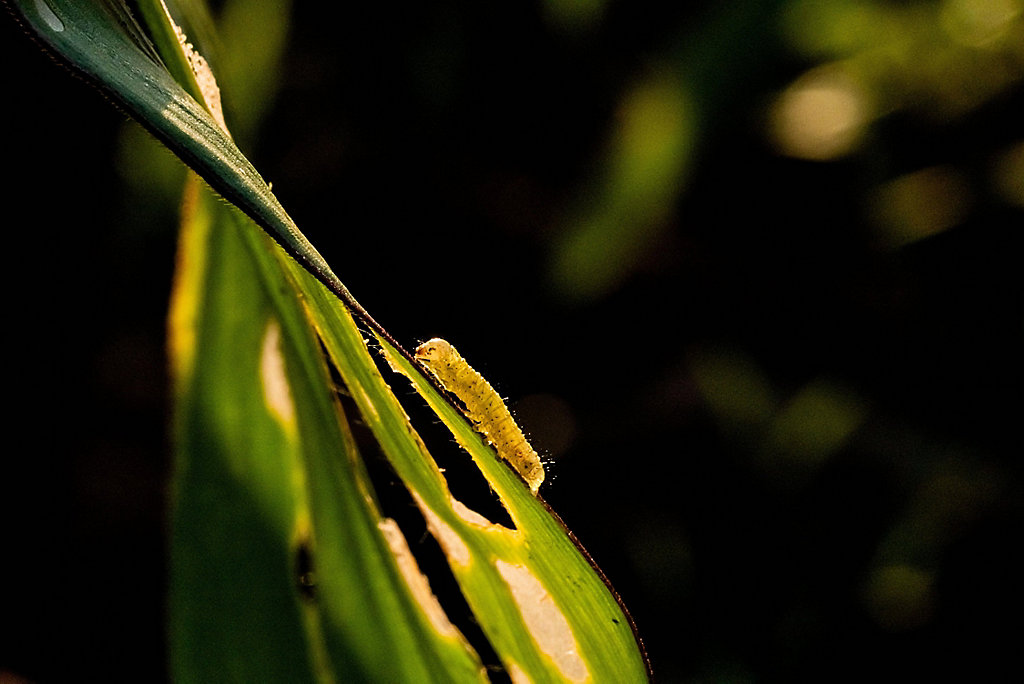FAW spreads by air during its moth phase. Strong-flying moths migrate from tropical and temperate climates to deposit their egg masses—1,500 to 2,000 or more per female—on leaves, grasses, and light-colored surfaces. The eggs hatch into larvae that become, through six phases and about 30 days, 1.5-inch-long eating machines. After four days of feasting, the caterpillars burrow into the ground and form pupae, from which the next generation of moths will emerge and take wing.5
FAW’s invasion of Africa in 2016 garnered world attention and mobilized an corps of researchers and agronomists.6 Organizations like CIMMYT (the International Maize and Wheat Improvement Center) and CGIAR, a global agricultural research partnership, performed extensive field research to surface economically and environmentally sustainable ways to control FAW and save crops.7 In 2019, the Food and Agriculture Organization of the United Nations set up Global Action for Fall Armyworm Control. The $500 million three-year initiative (2020–2022) has trained extension officers and farmers throughout Africa, Asia, and the Middle East to identify, scout for, and report FAW. It has also equipped them to manage infestations without resorting to blanket pesticide applications, a practice which has contributed to increased pesticide resistance.8 As a result, smallholders are gaining the control previously enjoyed only by large commercial growers in the Americas.
Breeding resistance
In FAW management, an ounce of prevention is worth literally tons of cure. Seed-based technologies that increase plant resistance to FAW represent the most effective as well as affordable and available crop protection. They don’t eliminate the need for pesticides. But they dramatically reduce their application, lowering farmers’ input and labor costs.
The first of these technologies is the genetic modification of seeds to incorporate Bacillus thuringiensis, a bacterium that kills FAW. So-called Bt corn has controlled FAW in the Americas for the last 15 years and accounts for the success of commercial maize crops in South Africa. Bt corn is seen as an important technology for small-scale growers in China.9 Bt-treated seed is another way to augment corn’s resistance to FAW.
However, because FAW can be resistant to Bt crops, scientists are now focused on breeding plants to be resistant to FAW. Corn hybrids developed for eastern and southern Africa, for example, marry insect-resistant germplasm drawn from Mexico with stress-resilient germplasm developed in sub-Saharan Africa. National and regional tests performed in 2020 suggest that these hybrids could reduce crop losses in sub-Saharan Africa by a factor of 8.6.10
Better field tactics
Field practices that foster plant health augment both natural and engineered host-plant resistance. These include suppressing weeds by not tilling the soil and keeping fields free of vegetation that might shelter FAW or make it easy for larvae to move from plant to plant.11 Many Africans are no longer intercropping with pumpkin, for example, as pumpkin has been shown to act as a bridge for the pest.12
Invented decades ago but newly relevant in the fight against FAW is the “push/pull” strategy. Intercropping with vegetation that FAW won’t eat pushes the insect from the cash crop, while bordering fields with vegetation that FAW desires pulls them away. A 2018 study in Kenya, Uganda, and Tanzania found that farmers reduced FAW infestation by 80 percent simply by planting Desmodium (a legume repellent to FAW) between rows of corn and Brachiaria (a grass attractive to FAW) around the field.13
FAW spreads by air during its moth phase. Strong-flying moths migrate from tropical and temperate climates to deposit their egg masses—1,500 to 2,000 or more per female—on leaves, grasses, and light-colored surfaces. The eggs hatch into larvae that become, through six phases and about 30 days, 1.5-inch-long eating machines. After four days of feasting, the caterpillars burrow into the ground and form pupae, from which the next generation of moths will emerge and take wing.5
FAW’s invasion of Africa in 2016 garnered world attention and mobilized an corps of researchers and agronomists.6 Organizations like CIMMYT (the International Maize and Wheat Improvement Center) and CGIAR, a global agricultural research partnership, performed extensive field research to surface economically and environmentally sustainable ways to control FAW and save crops.7 In 2019, the Food and Agriculture Organization of the United Nations set up Global Action for Fall Armyworm Control. The $500 million three-year initiative (2020–2022) has trained extension officers and farmers throughout Africa, Asia, and the Middle East to identify, scout for, and report FAW. It has also equipped them to manage infestations without resorting to blanket pesticide applications, a practice which has contributed to increased pesticide resistance.8 As a result, smallholders are gaining the control previously enjoyed only by large commercial growers in the Americas.
Breeding resistance
In FAW management, an ounce of prevention is worth literally tons of cure. Seed-based technologies that increase plant resistance to FAW represent the most effective as well as affordable and available crop protection. They don’t eliminate the need for pesticides. But they dramatically reduce their application, lowering farmers’ input and labor costs.
The first of these technologies is the genetic modification of seeds to incorporate Bacillus thuringiensis, a bacterium that kills FAW. So-called Bt corn has controlled FAW in the Americas for the last 15 years and accounts for the success of commercial maize crops in South Africa. Bt corn is seen as an important technology for small-scale growers in China.9 Bt-treated seed is another way to augment corn’s resistance to FAW.
However, because FAW can be resistant to Bt crops, scientists are now focused on breeding plants to be resistant to FAW. Corn hybrids developed for eastern and southern Africa, for example, marry insect-resistant germplasm drawn from Mexico with stress-resilient germplasm developed in sub-Saharan Africa. National and regional tests performed in 2020 suggest that these hybrids could reduce crop losses in sub-Saharan Africa by a factor of 8.6.10
Better field tactics
Field practices that foster plant health augment both natural and engineered host-plant resistance. These include suppressing weeds by not tilling the soil and keeping fields free of vegetation that might shelter FAW or make it easy for larvae to move from plant to plant.11 Many Africans are no longer intercropping with pumpkin, for example, as pumpkin has been shown to act as a bridge for the pest.12
Invented decades ago but newly relevant in the fight against FAW is the “push/pull” strategy. Intercropping with vegetation that FAW won’t eat pushes the insect from the cash crop, while bordering fields with vegetation that FAW desires pulls them away. A 2018 study in Kenya, Uganda, and Tanzania found that farmers reduced FAW infestation by 80 percent simply by planting Desmodium (a legume repellent to FAW) between rows of corn and Brachiaria (a grass attractive to FAW) around the field.13



